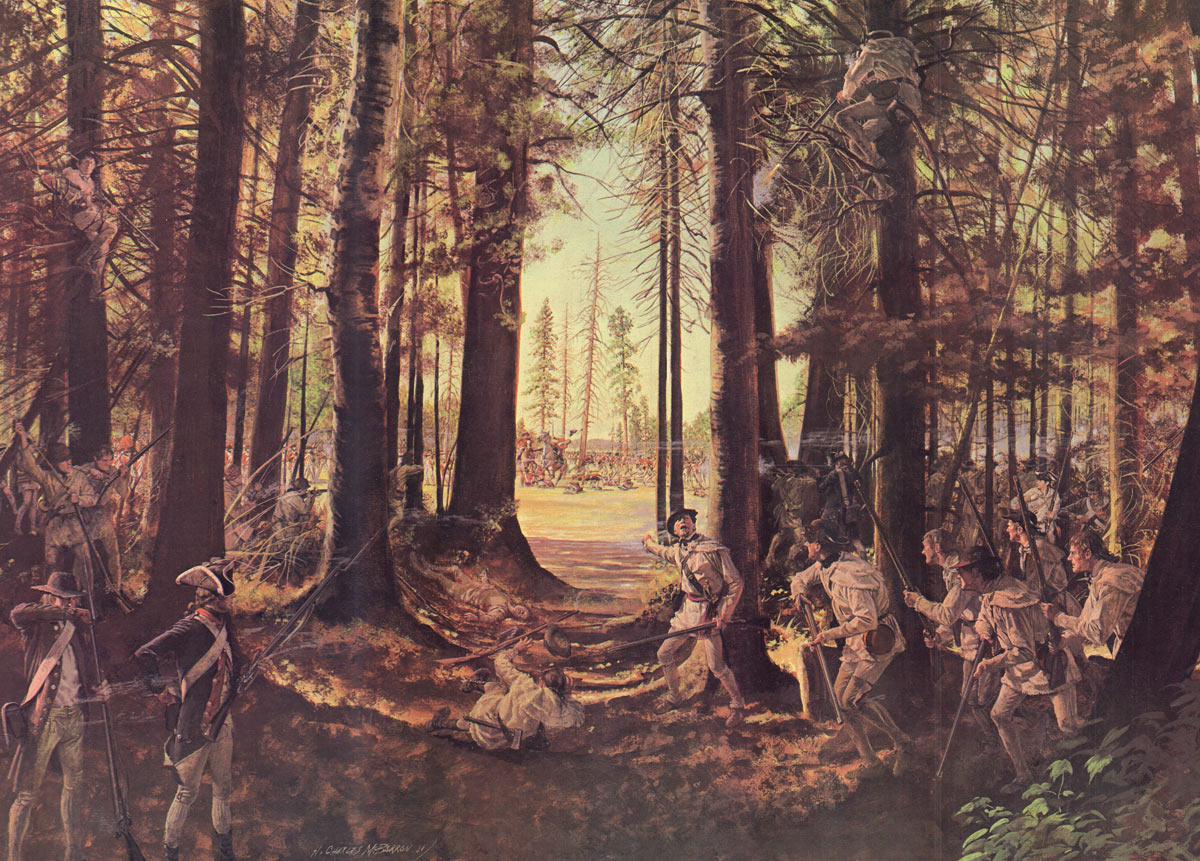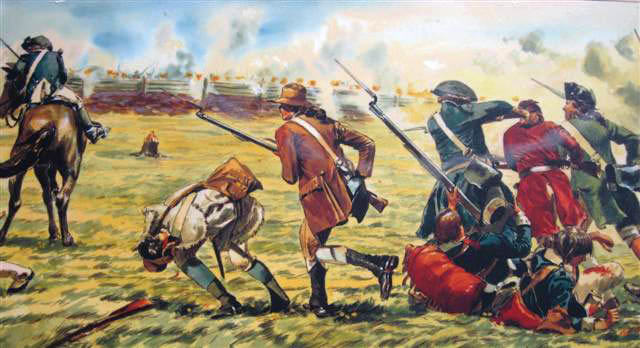The Battle fought on 19th September 1777 General Burgoyne had to win decisively but failed to do so
The previous battle of the American Revolutionary War is the Battle of Brandywine Creek
The next battle of the American Revolutionary War is the Battle of Paoli
To the American Revolutionary War index
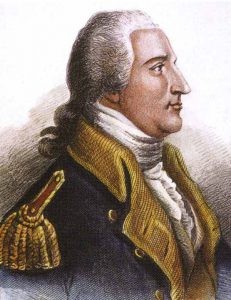
Major-General Benedict Arnold: Battle of Freeman’s Farm on 19th September 1777 in the American Revolutionary War
War: American Revolutionary War
Date of the Battle of Freeman’s Farm: 19th September 1777.
Place of the Battle of Freeman’s Farm: New York State on the west bank of the Hudson River, north of Albany.
Combatants at the Battle of Freeman’s Farm: British, Germans, Canadians, Indians and loyalist Americans against American Colonists.
Generals at the Battle of Freeman’s Farm: Major-General John Burgoyne commanded the British force. Major-General Horatio Gates commanded the American force. Gates’s principle subordinate was Major-General Benedict Arnold.
Size of the armies at the Battle of Freeman’s Farm:
The British force numbered around 6,000 men, while the American army numbered around 14,000 men.
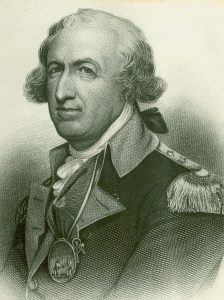
Major-General Horatio Gates: Battle of Freeman’s Farm on 19th September 1777 in the American Revolutionary War
Uniforms, arms and equipment at the Battle of Freeman’s Farm: The British wore red coats, with bearskin caps for the grenadiers, tricorne hats for the battalion companies and caps for the light infantry.
The German infantry wore blue coats and retained the Prussian style grenadier mitre cap with brass front plate.
The Americans dressed as best they could. Increasingly as the war progressed regular infantry regiments of the Continental Army wore blue uniform coats, but the militia continued in rough clothing.
The British and German troops were armed with muskets and bayonets. The Americans carried muskets, largely without bayonets. Virginia and Pennsylvania regiments and other men of the woods carried long, small calibre, rifled weapons. cannons, mostly of small calibre.
The British Army at the Battle of Freeman’s Farm:
Brigadier Simon Fraser’s Right Wing:
Major Lord Balcarres, commanding the light companies of the 9th, 20th, 21st, 24th, 29th, 31st, 47th, 53rd and 62nd Regiments of Foot.
Major Acland commanding the grenadier companies of the same regiments.
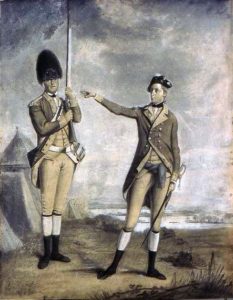
Grenadier and Officer of the British 62nd Regiment: Battle of Freeman’s Farm on 19th September 1777 in the American Revolutionary War
24th Foot
Breyman’s Jägers
Indians and Canadians.
Artillery Brigade of 8 cannon (six and three pounders).
Centre:
Brigadier Hamilton
The 9th, 20th, 21st and 62nd Regiments of Foot.
6 cannon (six and three pounders) commanded by Captain Jones.
Left Wing:
Commanded by Major-General Phillips and Baron Riedesel:
Riedesel’s Regiment
Specht’s Regiment
Rhetz’ Regiment
Captain Pausch’s Hesse Hanau Company of artillery
Baggage guard:
47th Regiment of Foot
Hesse Hanau Infantry
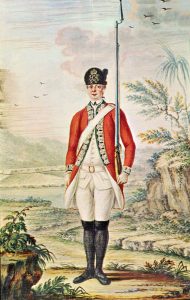
British Light Infantryman: Battle of Freeman’s Farm on 19th September 1777 in the American Revolutionary War
The American Army at the Battle of Freeman’s Farm:
Right Wing:
Under the personal command of Major-General Horatio Gates:
Brigadier Glover’s Continental Brigade
Colonel Nixon’s Continental Regiment
Brigadier Paterson’s Continental Brigade
Centre:
Brigadier Learned’s Continental Brigade
Bailey’s Massachusetts Regiment
Jackson’s Massachusetts Regiment
Wesson’s Massachusetts Regiment
Livingston’s New York Regiment
Left Wing:
Commanded by Major-General Benedict Arnold:
Cilley’s New Hampshire Regiment
Hale’s New Hampshire Regiment
Scammell’s New Hampshire Regiment
Van Cortlandt’s New York Regiment
Livingston’s New York Regiment
Connecticut Militia
Morgan’s Riflemen
Dearborn’s Light Infantry
Winner of the Battle of Freeman’s Farm:
The British remained on the field after the battle, but suffered significantly higher casualties than the Americans; casualties they could ill afford. This was a battle Burgoyne had to win. He did not, due to the inspired generalship of Benedict Arnold.
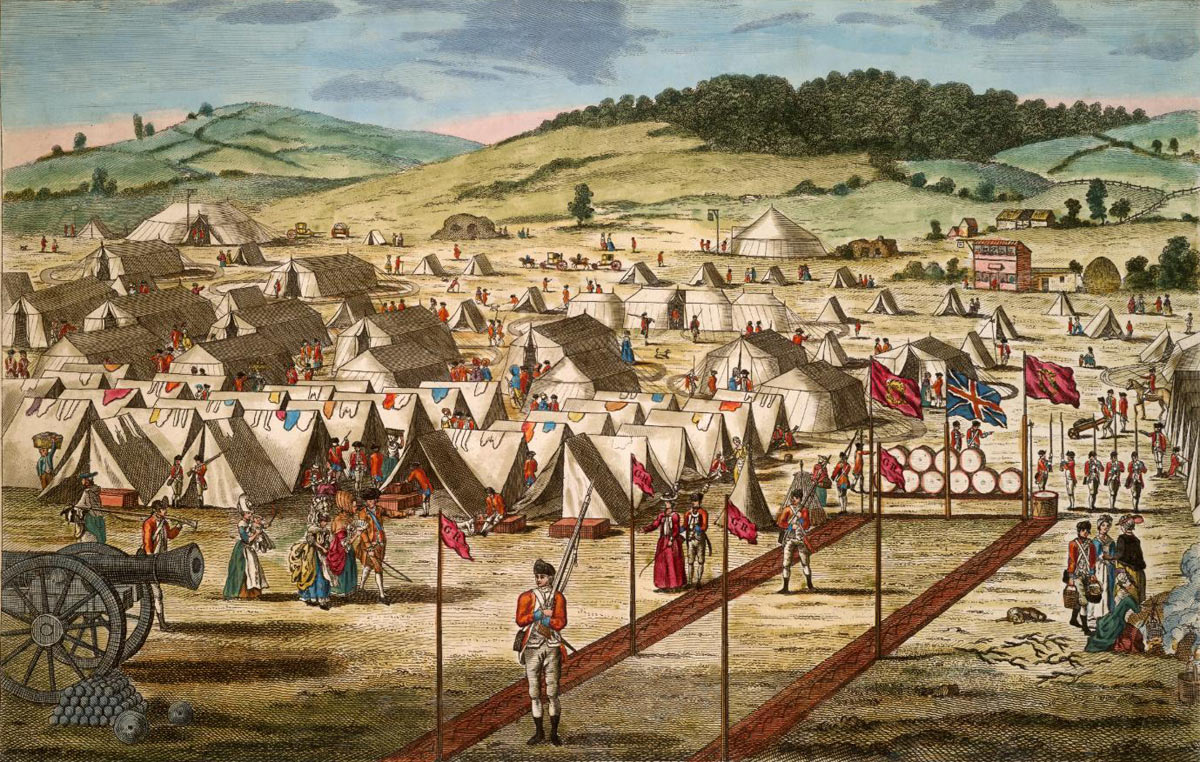
British encampment: Battle of Freeman’s Farm on 19th September 1777 in the American Revolutionary War
Background to the Battle of Freeman’s Farm:
By August 1777, Major-General John Burgoyne’s army had forced its way from Canada
down the Lake Champlain route to Fort Edward on the Hudson River. General Schuyler lay with the American Army to the south, covering the New York State capital, Albany. Burgoyne’s campaign to invade the American Colonies, which had seemed so promising when the army set out, was rapidly souring.
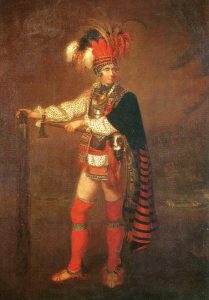
British officer as a Native American Chief: Battle of Freeman’s Farm on 19th September 1777 in the American Revolutionary War
Colonel Baum’s expedition to Bennington in search of supplies and horses was a disaster. The Americans were greatly encouraged by the success of Brigadier Stark’s New Hampshire Militia in the Battle of Bennington. Now the main American Northern Army lay north of the junction of the Mohawk and the Hudson Rivers, receiving a constant flow of reinforcements.
By contrast, British reinforcements were few and supplies had to be brought the long and difficult route from Canada; down Lake Champlain by boat, along the primitive road from Fort Anne to the Hudson River for onward transport, again by boat, to the army.
General Schuyler, the American commander until his removal in August 1777, established his army in a fortified position on Bemis Heights, on the west bank of the Hudson River.
Blamed for the loss of Fort Ticonderoga on 6th July 1777, Schuyler was removed from his post and ordered to Philadelphia, to answer for his conduct. Schuyler was replaced by Major-General Horatio Gates and Major-General Benedict Arnold, two mutually antipathetical personalities. Gates was a cautious ex-British officer. Arnold, one of the two leaders of the American attack on Quebec in 1776, was a mercurial man of action, able to inspire his troops to great feats in battle, constantly aggressive and on the lookout for the tactical advantage.
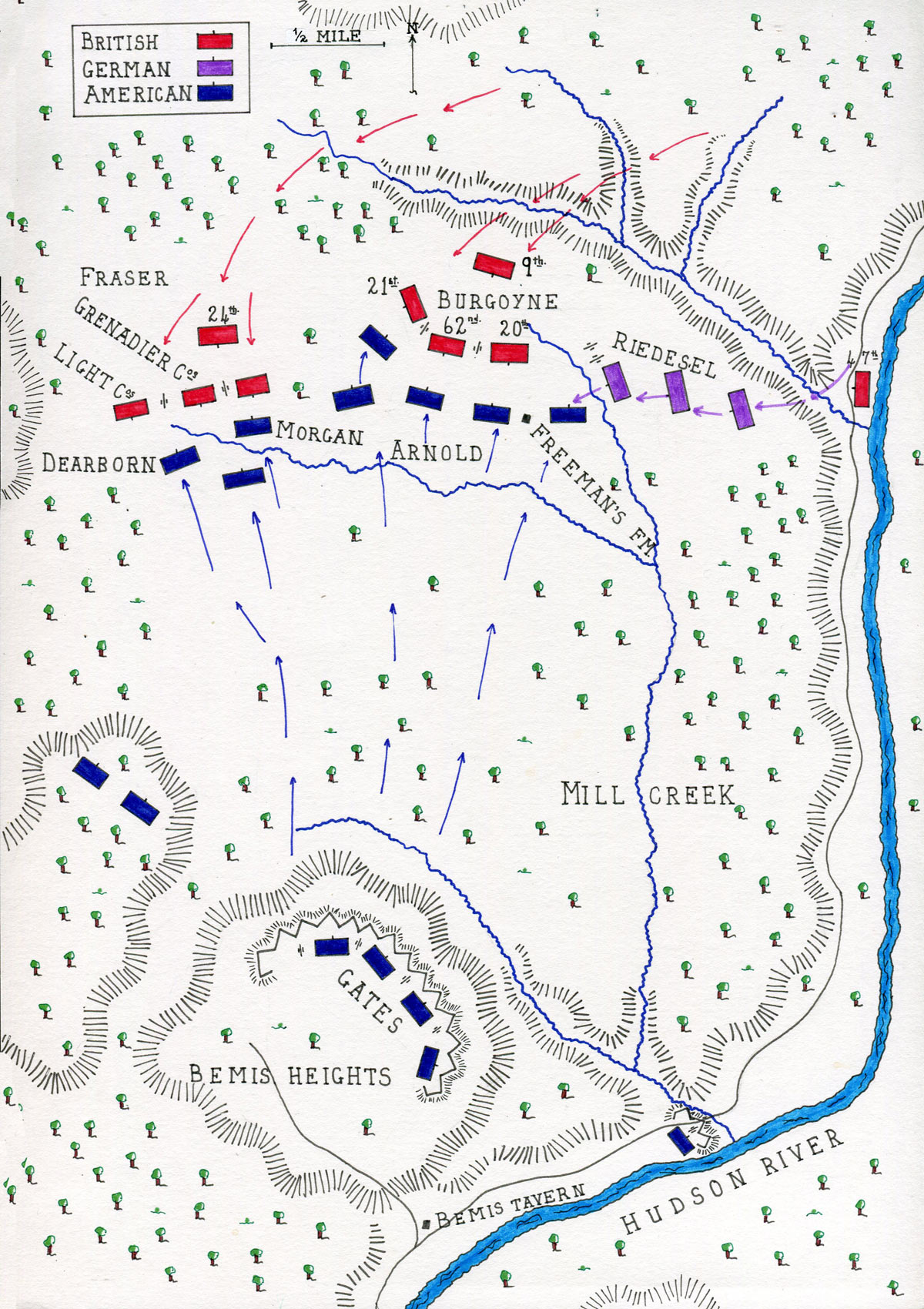
Map of the Battle of Freeman’s Farm on 19th September 1777 in the American Revolutionary War: map by John Fawkes
Account of the Battle of Freeman’s Farm:
On 19th August 1777, Burgoyne began a movement to encircle the American fortifications on Bemis Heights. Burgoyne’s intention was to take possession of the high ground to the west of the American fortifications and use the advantage of greater elevation to bombard the Americans from their flank.
Brigadier Fraser, with the British Right Wing, pushed into the woods along the northern side of a deep ravine. Hamilton followed him with the British Centre, accompanied by Burgoyne. Riedesel and his German troops remained on the riverside with the boats and supplies. Once in a line the three contingents would advance on the Americans.
Brigadier Fraser, with the British Right Wing, pushed into the woods along the northern side of a deep ravine. Hamilton followed him with the British Centre, accompanied by Burgoyne. Riedesel and his German troops remained on the riverside with the boats and supplies. Once in a line the three contingents would advance on the Americans.
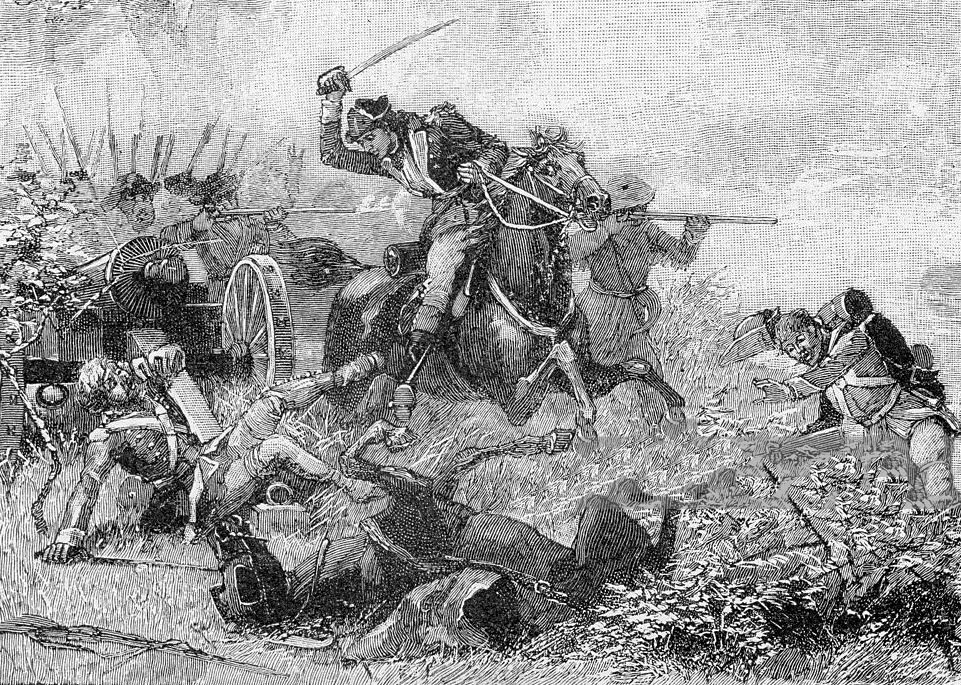
Benedict Arnold’s attack: Battle of Freeman’s Farm on 19th September 1777 in the American Revolutionary War
Gates had no aggressive plan with which to counter the British move. He planned to await attack in his fortified position on Bemis Heights. His subordinate, Arnold, had no such intention. He was determined to take the fight to the advancing British and use the advantage his men had in forest fighting.
Arnold pressed Gates to attack with the whole army. Gates refused, but finally agreed that Arnold could take his own division forward against the British line.
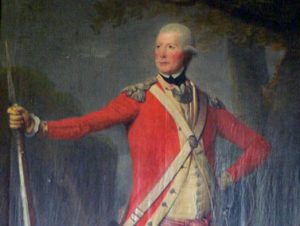
Lieutenant Colonel John Anstruther 62nd Regiment: Battle of Freeman’s Farm on 19th September 1777 in the American Revolutionary War
By the early afternoon of 19th August 1777, Burgoyne’s army cleared the ravine and was in a position to begin the advance, to be signalled by the discharge of a gun.
Morgan’s riflemen were the first American troops to attack, launching an assault on a small force of Canadians and Indians of Fraser’s Right Wing. Morgan’s men were followed by Arnold’s division of New Hampshire Continentals.
As the Canadians and Indians fell back, Morgan’s riflemen rushed on in pursuit and were dispersed by a British counterattack.
The New Hampshire Continentals were repelled by Fraser’s Grenadiers and Light Companies.
Burgoyne’s and Hamilton’s Centre approached Freeman’s Farm, leaving a substantial gap between themselves and Fraser’s more distant force. Arnold rallied his men and resumed the attack into the gap between the British Centre and Right Wing.
More American regiments from Arnold’s Division came up and joined the assault. Burgoyne’s flank regiment, the 21st Foot, was forced to fall back to avoid being overwhelmed. This left the 62nd Regiment at the angle of the line and under heavy fire.
A desperate battle developed between the attacking Americans and the regiments of the British Centre. During this fighting, which was described by veteran British soldiers as very heavy, General Phillips led a bayonet charge of the 20th Regiment, to enable the 62nd to withdraw and re-organise.
Gates, still in the American position on Bemis Heights, refused to commit further formations of the American army to the battle. If he had done so, it is generally accepted that the British Centre would have been overwhelmed.
In contrast to Gates’ refusal of requests for assistance from Arnold, Riedesel on the British Left responded with alacrity to the crisis. Leaving the British 47th to guard the baggage, Riedesel marched his regiments up the hill. He arrived to find the British Foot in great difficulty, and, without delay, launched a flank attack on the American troops. The fire of his artillery and foot was sufficient to relieve the pressure on the British regiments and force the Americans to withdraw. By this time night was falling.
The Americans fell back in some confusion to their fortified camp on Bemis Heights.
Casualties at the Battle of Freeman’s Farm:
Burgoyne’s army suffered heavy casualties among the regiments of the Centre: 600 killed, wounded and captured. Of these British casualties, 350 were from the 20th, 21st and 62nd Regiments. The 62nd suffered 285 casualties from a strength of around 340 in its line companies. The Americans took 350 casualties, killed, wounded and captured.
Follow-up to the Battle of Freeman’s Farm:
Burgoyne’s senior subordinates urged that the attack on the American position on Bemis Heights be pressed the next day. The Americans were in disorder after the failure of Arnold’s attack at Freeman’s Farm and it may be that an immediate attack would have succeeded. However, Burgoyne preferred to wait and see if Clinton was coming up the Hudson from New York to meet him, before launching a further offensive operation. The opportunity, if there was one, quickly passed.
Freeman’s Farm is one of the decisive battles of the Revolutionary War, leading directly to Burgoyne’s surrender.
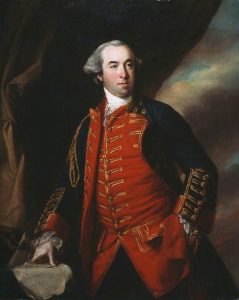
Major-General William Phillips Royal Artillery: Battle of Freeman’s Farm on 19th September 1777 in the American Revolutionary War
Traditions and anecdotes from the Battle of Freeman’s Farm:
- In 1776, Colonel Morgan was captured in the American attack on Quebec, leading his corps of Virginia Riflemen. Exchanged by the British, Morgan re-raised his corps. This time the recruits were mainly Pennsylvanians; Scotch Irish, Presbyterians and German settlers. The Corps was renowned for its hardihood, able, it is said, to march forty miles in a day, and for its marksmanship. Tradition had it that the men practised marksmanship by shooting apples off each other’s heads. This seems an unlikely waste of apples, if not of the heads. The great drawback in the rifle was its slow rate of reloading. General Washington did all he could to discontinue the use of rifles in favour of muskets.
- Morgan and Arnold were close companions from the Quebec campaign. They spent the hours before Freeman’s Farm carousing. Together, they urged, perhaps bullied, Gates to attack the British in the woods rather than skulk in the fortifications on Bemis Heights. At times, Gates feared they would assault him. Finally, Gates agreed to Arnold’s aggressive move, but refused him any regiments other than those of his own division.
- General Phillips, the senior Royal Artillery officer who led the bayonet charge of the 20th Regiment to relieve the 62nd Regiment at the Battle of Freeman’s Farm, was the officer who so distinguished himself as a captain at the Battle of Minden, in Germany in 1759, that Prince Ferdinand awarded him a sum of money.
References for the Battle of Freeman’s Farm:
History of the British Army by Sir John Fortescue
The War of the Revolution by Christopher Ward
The American Revolution by Brendan Morrissey
Saratoga by Richard Ketchum
The previous battle of the American Revolutionary War is the Battle of Brandywine Creek
The next battle of the American Revolutionary War is the Battle of Paoli
To the American Revolutionary War index
